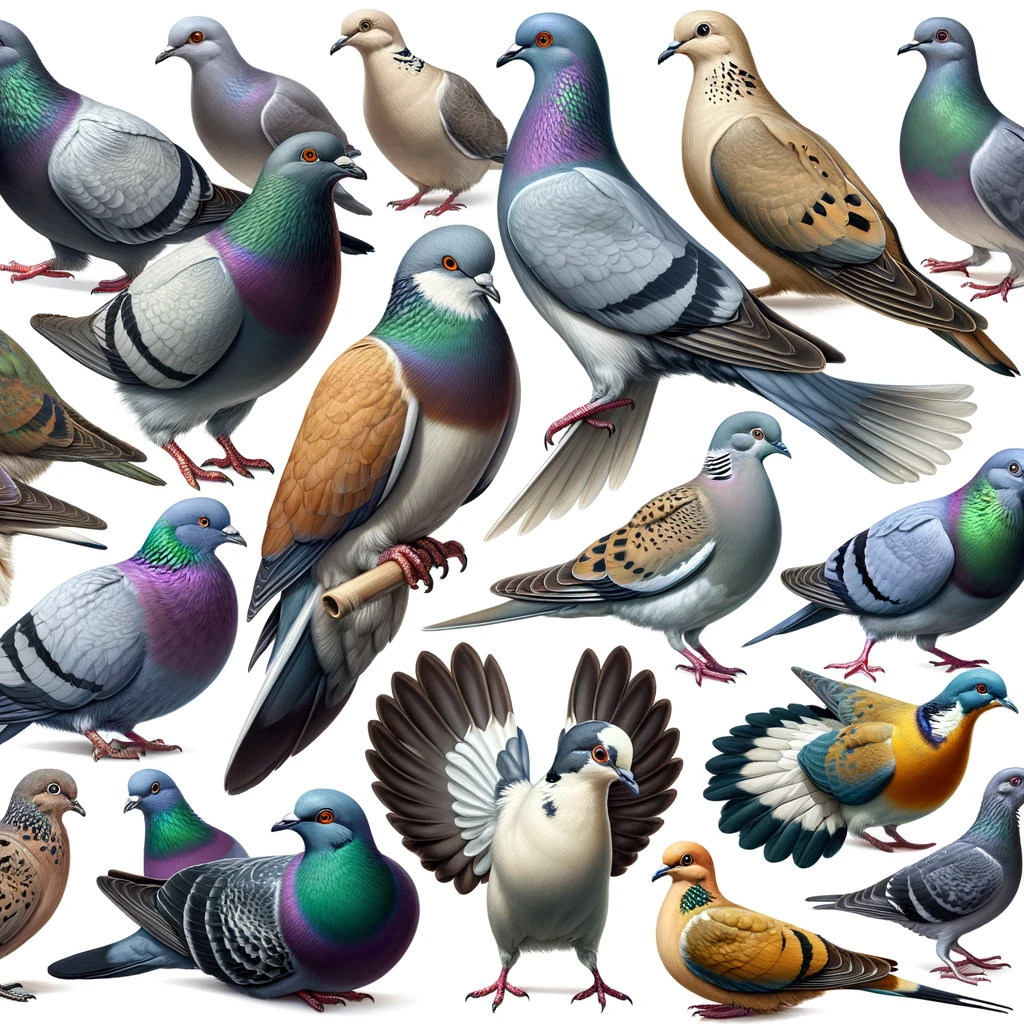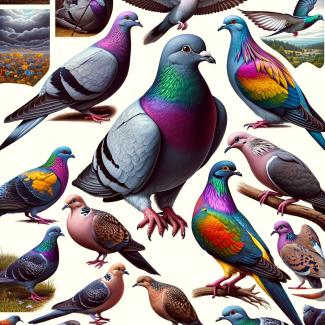
Encompassing pigeons, doves, and their extinct relatives, Columbiformes is a distinct order of medium-sized birds with stout bodies, small heads, short legs, and slender pointed wings well-suited for powered flight. With over 300 extant species divided into 2 families, Columbiformes possesses a global distribution found everywhere except extreme polar regions and has thrived alongside humanity for thousands of years.
The early evolutionary origins of ancestral Columbiformes trace back to the late Cretaceous period over 75 million years ago. From this primitive seed and fruit-eating stock, successive lineages specialized towards varied environments - manifesting immense speciation as continents drifted. Still, they retained key traits facilitating thriving across urban parks and isolated islets alike worldwide. Wild escaped descendants of domesticated breeds now flourish on every continent.
Today's diversity spans diminutive ground doves probing patio bird feeders to vibrant fruit pigeons decorating tropical forest canopies. Bronzewing pigeons patrol Australia's red heart as crowned pigeons forage New Guinean rainforests. Though often underappreciated, the perseverance and adaptations making Columbiformes ubiquitous components of almost every landscape reveal their evolutionary successes cultivated over eons of coexistence with humanity and diverse ecosystems alike.
Characteristics
Physical Features
Columbiformes display a spectrum of sizes spanning minute columbin species like African olive and Guinea bronze-winged pigeons under 20 centimeters up to the 60-centimeter giants crowned pigeon of New Guinea and Victoria crowned pigeon from Fiji. Stout seed-eating forms prevail but fruit specialists diverge towards more slender frames.
Compact plumage insulates the body while large feathers create lifting surfaces loaded with intricate muscular controls granting extreme maneuverability and aerial agility rivaling songbirds. Sturdy yet lightweight bills easily access fruits and seeds. Distinctive cooing “hoo hoo” contact notes facilitate flock communication and pair bonding echoing across forests and city blocks alike.
Understated grays, browns, and soft creams camouflage many against preferred terrestrial habitats. But brilliant iridescent patches and spots ornament heads and necks of numerous fruit pigeons - likely visual social signals. Such ostentation probably encouraged early human captivation beyond vital ecosystem services or meat contributions.
Behavioral Traits
Primarily herbivorous, Columbiformes consume a variety of seeds, grains, nuts, berries, and occasionally foliage across terrestrial habitats from forests to grasslands to human parks where food proves abundant. Their grit-filled muscular gizzards efficiently grind tough plant foods.
While some species lead more solitary lives, Columbiformes frequently form sizeable flocks centered around rich food sources. Pairs may isolate briefly for breeding but communally roost and feed while socializing through constant contact coos.
Remarkable homing abilities lead far-ranging individuals to return precisely to traditional sites even when displaced thousands of kilometers away. Migratory patterns concentrate seasonal movements across specific corridors.
Reproduction and Lifespan
Monogamous pairs engage in characteristic head-bobbing courtship displays. Males gather nesting material while the female crafts a flimsy platform twig structure from debris in a tree or cliff crevice. Typical clutch size ranges between 1-3 eggs requiring 14-20 days of incubation.
The altricial helpless hatchlings rely completely upon regurgitated crop milk from both parents until fledging up to 30 days later. Most survive 3-5 years in the wild but protected city pigeons may persist over 10 and large crowned pigeons have lived beyond 20 years in captivity.
Extant Families
Columbidae (pigeons and doves)
Containing over 310 species, Columbidae represents the only family within Columbiformes with living members today. They thrive on all continents except Antarctica. With members displaying remarkable variety in size, plumage, habitat preferences, and behaviors, defining features include stout seed-hulling bills, compact bodies, elongated wings, smooth head feathers, and highly maneuverable flight capacities.
Didunculidae (tooth-billed pigeon)
solely represented by the Samoan tooth-billed pigeon or manumea, this unusual lineage of now-extinct pigeons was restricted to Samoa and nearby islands. They demonstrated massive bills more reminiscent of parrots suited to opening hard nuts and seeds other doves could not access. Their isolated island distribution saw them extinct due to habitat pressures and overhunting by the early 1900s.
While the varied members contained across the single expansive family today showcase diverse lifestyles, ancestral Columbidae stock succeeded broadly thanks in part to flexible food habits focused around ubiquitous seeds but with room for fruits that encouraged utilizing diverse forest and open country habitats available across most warmer landmasses over time.
Global Distribution and Habitat
With over 300 extant species, Columbiformes enjoy an extensive global distribution - inhabiting every continent except Antarctica as well as many remote islands and archipelagos. Only the harshest desert and tundra zones restrict ranges, but both migratory and resident populations inhabit diverse landscapes.
Generalist food habits centered on abundant seeds, grains, and occasional fruits facilitate exploiting habitats wherever requisite plant foods abound readily. Thus columbids flourished within tropical and temperate forests alongside humanity's agricultural lands and cities loaded with grains and ornamental berry plants.
Opportunistic tendencies readily incorporate exotic cultivars and ornamentals into diets as ranges expand widely thanks to tolerance of disturbed areas. Cliff-side specialists like the Laurel pigeons accessing mineral licks at heights are the exception to such flexibility. But mostly only extreme cold limits ancestral distributions.
Accordingly, beyond dense forests, fruiting shrublands, and parks, columbids adapted to arid habitats like Middle East wadis to Australian Acacia bushlands and Andean rain-shadow valleys. Diverse soils and topography fostered immense genetic radiation as continents drifted. Today blending into nearly all warm fertile lands, the doves remain planted across most countryside thanks to versatile ecology hallmarking their resilience worldwide.
Ecological Importance
As prolific seed consumers across most forest and scrubland habitats, Columbiformes provide essential seed dispersal services benefiting diverse trees and shrubs. Regurgitating and defecating abundant undamaged seeds, pigeons and doves may traverse substantial daily distances - spreading favored plant reproductive stock far beyond sources. Thereby they enhance genetic distribution and colonization success following seasonal fruit masts.
Preferential fruit targeting shapes advantageous plant architecture and timing strategies towards avian syndromes through co-evolutionary processes over eons as well. For example, the African olive pigeon follows ripening patterns selecting trees producing sequential bounties sustaining their migrations across the Ethiopian highlands.
Pigeon and dove populations additionally serve as monitors revealing plant community food availability and habitat stability. Their numbers and breeding success fluctuate markedly responding to precipitation patterns, seasonal flowering, and land conversion rates - amplifying signals of scarcity that provide advanced warning to conservationists of impending ecosystem disruptions requiring intervention.
Lastly, abundant grounded doves and terrestrial foragers represent easy prey for many mammalian and avian predators - providing nutrition transfers into forest and jungle food webs to nourish rainforest eagles, leopards, snakes and small cats. Thereby versatile columbids anchor ecological structures across most warmer lands.
Columbiformes in Nepal
Nepal’s broad elevation range spanning lowland Terai forests to the world’s highest peaks sustains remarkable Columbiformes diversity. Around 20 species reside or migrate through the country annually - ranging from frosted ground doves ascending the Himalayan foothills to speckled wood pigeons adorning middle hill oak stands to emerald doves decorating the steamy riverine valleys descending towards the Gangetic plain from whence winter flocks arrive.
The most visible members ornament village squares across Nepal’s rural expanse thanks to close cultural bonds with humanity persisting for millennia. Descendants of once domesticated varieties, feral Nepalese pigeons display intricate bred color diversity from snowy whites to metallic sheens, unlike most wild brethren.
Sacred symbolism also cloaks select species - including worship of Shardul or Nepal’s endemic wood pigeon during annual Teej celebrations honoring the divine goddess Parbati. Most populations remain widespread but ground nesting habits make some vulnerable to uncontrolled harvesting. Expanding protected grove areas promises to secure the continuity of Nepal’s distinctive columbid heritage amidst the region’s rising development pressures.
Conservation Challenges and Efforts
Thanks to versatile seed diets and broad habitat tolerance, most Columbiformes species remain widespread and numerous. However, increasing pressures have pushed over 75 species onto threatened or near threatened conservation status lists - including endangered Socorro doves and Trocaz pigeons confined to single remote islands. Beyond outright habitat destruction, hunting and nest harvests for food or the pet trade also pose local threats.
As frugivores tightly bonded with preferred tree species, deforestation from logging, land conversion, and fires disproportionately impact forest pigeons the most. But even human commensal species face contamination risks accumulating within urban and agricultural grains they exploit. A deadly circovirus epidemic spread by free-flying city pigeons as recently as the 1980s decimated domestic racing breeds.
However, Columbiformes remain surprisingly understudied despite cultural significance and ecosystem services - limiting current protective interventions. Expanding radio-tracking of key threatened species promises to pinpoint fragile populations and migration choke points requiring habitat prioritization. Campaigns promoting heritage significance show progress in curbing traditional nest harvests in remote indigenous communities through supplemental food provisions while emphasizing status as pollinating seed dispersers benefiting people.
Targeted conservation breeding initiatives also make headway in restoring unique island endemics like the Negros bleeding heart dove thought extinct until rediscovered in the 1990s. Integrating cultural reverence with expanded ecological understanding supports dove diversity persistence through coming challenges worldwide.
Conclusion
Columbiformes unique capacity among birds for expanding alongside humanity over thousands of years testifies to an overlooked resilience built upon versatile pigeon and dove chassis well-equipped through adaptive physiology and flexible food habits to spread across dramatically disparate settings worldwide - from desolate Pacific atolls to greenbelts bisecting modern megacities.
Thereby doves persist in planting preferable future forests through the transport of seeded potential beyond horizons while also monitoring ecosystem functionality through their numbers revealing the stability of partner fruiting trees essential for nurturing subsequent generations. When extreme conditions or overharvesting interrupts this balancing act, the birds stand poised to inherit the scorched soils again when people move onwards.
In Nepal, ancient bonds with Columbids blessed through sacred symbolism guarantee continued tolerance even amidst modernizing rural regions. Maintaining functioning broadleaf woodlands and subtropical forest reserves promises to nurture the future of Nepal's distinctive high-altitude doves alongside feral counterparts to uphold vital ecosystem services upon which both human and wildlife health relies.
Thereby pigeons will retain their dolefule coos echoing down from foothill cornices towards farmsteads awakening at dawn. Celebrating traditional relations with adaptable columbids through coming change promises mutual benefits sustaining Nepali community heritage.

